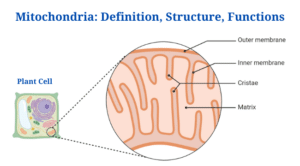Mitochondria Definition
- Mitochondria are oxygen-consuming ribbon-shaped cellular organelles that float freely within the cell.
- They are called as the “powerhouse of the cell” because they provide all of the cell’s biological energy by oxidising the available substrates.
- The mitochondrial enzymatic oxidation of chemical molecules releases energy.
- Because mitochondria serve as energy generators, they can be found in abundance on sperm tails, muscle cells, liver cells (up to 1600 mitochondria), microvilli, and oocytes (more than 300,000 mitochondria), among other places.
- In most cells, there are roughly 2000 mitochondria, which account for about 25% of the cell volume.
- Richard Altmann named mitochondria bioblasts when he first identified them in 1890. The term “mitochondrion” was coined by Benda in 1897.
Mitochondria Structure
Mitochondria are malleable organelles with a double-membrane structure that are movable. It has a diameter of 0.5 to 1.0 micrometre. The outer membrane, inner membrane, intermembrane space, and matrix are the four different domains.
- Two membranes surround the organelle: a smooth outer membrane and a folded or tubular inner mitochondrial membrane with a substantial surface area that encloses the matrix region.
- Between the inner and outer membranes is the intermembrane gap.
- The number and structure of mitochondria, as well as the amount of cristae on them, varies greatly between cell types.
- Tissues with a high rate of oxidative metabolism, such as heart muscle, have mitochondria with a high number of cristae.
- The morphology of mitochondria can vary even within one type of tissue, depending on their functional condition.
- Proteins abound in both mitochondrial membranes.
Figure: Diagram of Mitochondria (Plant Cell), Created with BioRender.com
Mitochondrial Membrane (Outer)
- In terms of structure and chemical content, the outer mitochondrial membrane is more similar to the plasma membrane.
- Small molecules can be exchanged between the cytoplasm and the intermembrane gap thanks to porins in the outer membrane.
Mitochondrial Membrane (Inner)
- Many enzymes, coenzymes, and other electron transport chain components can be found in the inner mitochondrial membrane. It also contains proton pumps and a large number of permease proteins that transport compounds including citrates, ADP, phosphate, and ATP.
- The inner mitochondrial membrane contains tennis-racket shaped F1 particles that contain the ATP-ase enzyme for ATP generation and puts out finger-like outgrowths (cristae) towards the mitochondrion lumen.
- Even tiny molecules are unable to pass through the inner mitochondrial membrane (with the exception of O2, CO2, and H2O)
- The import and export of key metabolites is ensured by many transporters in the inner membrane.
Intermembrane Space
- It is a word used to describe the space between two membranes It’s the space between the outer and inner membranes of the mitochondria, and it’s made up of the same stuff as the cytoplasm of the cell.
- In the intermembrane gap, there is a variation in protein content.
Mitochondrial Matrix
- The soluble enzymes of the Krebs cycle, which totally oxidise acetyl-CoA to produce CO2, H2O, and hydrogen ions, are found in the mitochondrial matrix, which is a liquid (colloidal) area ringed by the inner membrane. NAD and FAD molecules are reduced by hydrogen ions, and both send hydrogen ions to the respiratory or electron transport chain, where oxidative phosphorylation occurs to form energy-rich ATP molecules.
- Mitochondria also include single or double circular and double-stranded DNA molecules known as mt DNA, as well as 55S ribosomes known as mitoribosomes, in their matrix.Mitochondria are classified as semi-autonomous organelles since they can generate 10% of their proteins using their own protein-synthesis machinery.
Mitochondrial Functions
- The production of energy is the most crucial function of mitochondria. Mitochondria make the chemical adenosine triphosphate (ATP), which is one of the cell’s energy currencies and is used to power a variety of cellular activities and mechanisms.
- The nutrition’s simpler molecules are transported to the mitochondria, where they are digested and charged molecules are produced. When these charged molecules come into contact with oxygen, they form ATP molecules. Oxidative phosphorylation is the name for this process.
- Mitochondria can also produce heat (brown fat) and store iron-containing pigments (Heme ferritin), as well as Ca2+ ions and HPO42–. (or phosphate; for example, bone osteoblasts or yolk proteins).
- Mitochondria assist cells in maintaining correct calcium ion concentrations within cell compartments.
- The mitochondria also aid in the formation of certain blood components and hormones such as testosterone and oestrogen.
- Ammonia is detoxified by enzymes found in the mitochondria of liver cells.
- Apoptosis, or programmed cell death, is another process in which mitochondria play an important role.
- An organ’s function can be harmed by abnormal cell death caused by mitochondrial malfunction.
Click Here for Complete Biology Notes
Mitochondria Citations
- Koolman, J., &Röhm, K.-H. (2005). Color atlas of biochemistry. Stuttgart: Thieme.
- Alberts, B. (2004). Essential cell biology. New York, NY: Garland Science Pub.
- Verma, P. S., & Agrawal, V. K. (2006). Cell Biology, Genetics, Molecular Biology, Evolution & Ecology (1 ed.). S .Chand and company Ltd.
- https://alevelbiology.co.uk/notes/mitochondria-structure-and-functions/
- https://biology.tutorvista.com/animal-and-plant-cells/mitochondria.html
Related Posts
- Phylum Porifera: Classification, Characteristics, Examples
- Dissecting Microscope (Stereo Microscope) Definition, Principle, Uses, Parts
- Epithelial Tissue Vs Connective Tissue: Definition, 16+ Differences, Examples
- 29+ Differences Between Arteries and Veins
- 31+ Differences Between DNA and RNA (DNA vs RNA)
- Eukaryotic Cells: Definition, Parts, Structure, Examples
- Centrifugal Force: Definition, Principle, Formula, Examples
- Asexual Vs Sexual Reproduction: Overview, 18+ Differences, Examples
- Glandular Epithelium: Location, Structure, Functions, Examples
- 25+ Differences between Invertebrates and Vertebrates
- Lineweaver–Burk Plot
- Cilia and Flagella: Definition, Structure, Functions and Diagram
- P-value: Definition, Formula, Table and Calculation
- Nucleosome Model of Chromosome
- Northern Blot: Overview, Principle, Procedure and Results

















